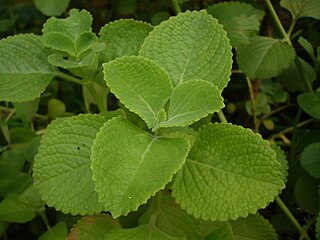
Coleus amboinicus, synonym Plectranthus amboinicus, is a semi-succulent perennial plant in the family Lamiaceae with a pungent oregano-like flavor and odor. Coleus amboinicus is considered to be native to parts of Africa, the Arabian Peninsula, and India, although it is widely cultivated and naturalized elsewhere in the tropics where it is used as a spice and ornamental plant. Common names in English include Indian borage, country borage, French thyme, Indian mint, Mexican mint, Cuban oregano, soup mint, Spanish thyme. The species epithet, amboinicus refers to Ambon Island, in Indonesia, where it was apparently encountered and described by João de Loureiro (1717–1791).

Ulmus thomasii, the rock elm or cork elm, is a deciduous tree native primarily to the Midwestern United States. The tree ranges from southern Ontario and Quebec, south to Tennessee, west to northeastern Kansas, and north to Minnesota.

Ulmus lamellosa, commonly called the Hebei elm, is a small deciduous tree native to four Chinese provinces, Hebei, Henan, Nei Mongol, and Shanxi, to the west and south of Beijing.
Ulmus pseudopropinquaWang & Li, occasionally known in the United States as the Harbin spring elm, is a small deciduous tree found only in Heilongjiang, the northeasternmost province in China. The tree has not been studied comprehensively, and it has been speculated it may be a natural hybrid of Ulmus davidiana var. japonica and Ulmus macrocarpa.

The American Elm cultivar Ulmus americana 'Columnaris' was propagated by R. E. Horsey of the Rochester N.Y. Parks Department from a tree found by Mr John Dunbar at Conesus Lake, New York, in 1911, and originally described as a forma, Ulmus americana L. f. columnaris, f. nov.Rehder (1922). It was the earliest of a number of compact, columnar American elm cultivars, to be followed by 'Ascendens' and 'Augustine Ascendening'.
The American Elm cultivar Ulmus americana 'Fiorei' was raised by the Charles Fiore Nurseries, Prairie View, Illinois, before 1949, and first listed as 'Fiorii', Fiore Elm, without description. It is no longer listed by the company.
The elm cultivar Ulmus 'Myrtifolia', the Myrtle-leaved Elm, first appeared in nursery and horticultural lists from the 1830s, as Ulmus myrtifolia and Ulmus campestris myrtifolia, the name Ulmus myrtifoliaVolxem being used at Kew Gardens from 1880. Lawson's nursery of Edinburgh appears to have been the earliest to list the tree. 'Myrtifolia' was listed by Nicholson in Kew Hand-List Trees & Shrubs (1896), but without description. It was later listed as a cultivar and described by Rehder in 1939 and by Krüssmann in 1962.

Bergenia crassifolia is a species of flowering plant of the genus Bergenia in the family Saxifragaceae. Common names for the species include heart-leaved bergenia, heartleaf bergenia, leather bergenia, winter-blooming bergenia, elephant-ears, elephant's ears, Korean elephant-ear, badan, pigsqueak, Siberian tea, and Mongolian tea.

Peperomia alata, commonly known as the winged peperomia, is a species of plant in the genus Peperomia of the family Piperaceae. Its native range covers most of tropical and subtropical America, from southern North America through West Indies and Central America to South America. It can also be found in Florida, although there it is apparently rare, known for certain only from swamps in Collier County.

Garcinia sessilis, commonly known as heilala in Tongan, is an evergreen tree native to the Pacific regions of Tonga. The heilala flower is the national flower of Tonga.
Peperomia venezueliana is a species of herb and hemiepiphyte subshrub from the genus Peperomia. It grows in wet tropical biomes. It was discovered by Casimir de Candolle in 1866, in Venezuela..
Peperomia venusta is a species of subshrub from the genus Peperomia. It grows in wet tropical biomes. It was first described by Truman G. Yuncker in 1957.
Peperomia villipetiola is a species of plant from the genus Peperomia. It was first described by Casimir de Candolle and published in the book "Notulae Systematicae. Herbier du Museum de Paris 3: 43. 1914.". It is endemic to Peru. First specimens were collected by Vidal-Sénège, M. Its etymology came from the words "villi" and "petiola".

Peperomia uaupesensis is a species of epiphyte from the genus Peperomia. It was first described by Truman G. Yuncker and published in the book "Boletim do Instituto de Botânica 3: 194–195, f. 171. 1966. ". Its etymology came from "Vaupes".

Peperomia vincentiana is a species of herb from the genus Peperomia. It was first described by Truman G. Yuncker and published in the book "London Journal of Botany 4: 415. 1845.". In Colombia, its elevation range is 2600 meters. Its etymology came from the Ubate-Susa highway in Cundinamarca.

Peperomia umbrigaudens is a species of epiphyte from the genus Peperomia. It was first described by Truman G. Yuncker and published in the book "Annals of the Missouri Botanical Garden 37(1): 81. 1950. ". It primarily grows on wet tropical biomes.

Peperomia unduavina is a species of plant from the genus Peperomia. It was first described by Casimir de Candolle and published in the book "Repertorium Specierum Novarum Regni Vegetabilis 13: 306. 1914.". It primarily grows on wet tropical biomes It is named after Unduavi, the place where the species were discovered.

Peperomia ursina is a species of epiphyte or lithophyte from the genus Peperomia. It was first described by Michael Howard Grayum and published in the book "Phytologia 79(2): 112–113. 1995[1996]". It primarily grows on wet tropical biomes.

Peperomia ternata is a species of hemiepiphytic subshrub from the genus Peperomia. It was first described by Casimir de Candolle and published in the book "Bulletin de l'Herbier Boissier 6(7): 509. 1898. ". It primarily grows on wet tropical biomes.

Peperomia thollonii is a species of flowering plant from the genus Peperomia. It was first described by Casimir de Candolle and published in the book "Notulae Systematicae. Herbier du Museum de Paris 3: 38. 1914 ". It primarily grows on wet tropical biomes. Its etymology came from François-Romain Thollon, a botanist and plant collector who worked in Gabon and the Congo.














